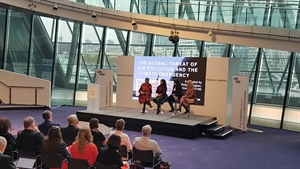Mayor announces £25m polluting scrappage scheme for older cars as ULEZ reports positive start
Wed 23 October 2019
View all news

The Mayor of London, Sadiq Khan has announced a £25m ‘scrap for cash’ dirty vehicle scheme focused on older, dirty vehicles and specifically for low-income and disabled Londoners. The Mayor says that the scrappage scheme aims to help Londoners ahead of the Ultra Low Emission Zone expansion in 2021 up to the North and South Circular roads.
The new scheme will run alongside the existing £23m fund for micro businesses, sole traders and charity owners who want to scrap older vans.
Motorists can apply for:
-
£1,000 for scrapping a motorcycle or moped.
-
£2,000 for scrapping a car not compliant with the ULEZ.
Alongside this, eligible applicants will be able to take advantage of a number of other offers and benefits such as one year’s free membership of Santander Cycles for all journeys up to 30 minutes.
Sadiq Khan said: “Air pollution is a national health crisis that is stunting the lung development of our children and leading to thousands of premature deaths. City leaders across the world are united in raising the alarm about the dangers posed by poor air quality.
The Mayor made the announcement as he hosted an International Air Quality summit at City Hall, bringing together city leaders, environmentalists and businesses.
Meanwhile, new figures released by City Hall show there are now 13,500 fewer polluting cars being driven into central London every day and a significant drop in harmful air pollution, since the Mayor introduced the Ultra Low Emission Zone (ULEZ) six months ago.
The ULEZ, which operates in the Central London Congestion Charging zone, is the world’s first.
Since introducing the ULEZ data presented by City Hall reveals that:
-
Roadside nitrogen dioxide (NO2) pollution has reduced by 36 per cent in the zone. Analysis in the report estimates that the reduction in NO2 pollution solely attributable to the ULEZ is 29 per cent.
-
None of the air quality monitoring sites located on ULEZ boundary roads have measured an increase in NO2 pollution levels since the scheme was introduced in April 2019.
-
From March to September 2019 there was a large reduction in the number of older, more polluting, non-compliant vehicles detected in the zone: some 13,500 fewer on an average day, a reduction of 38 per cent.
-
77 per cent of vehicles now in the zone now meet the ULEZ emissions standards. This is much higher than the 39 per cent seen in February 2017 and the 61 per cent in March 2019 .
-
NOx emissions from road transport in the central zone are now 31 per cent (200 tonnes) lower than if the scheme was not in place. This is ahead of schedule to meet the 45 per cent NOx emission reduction expected in the first year.
-
There was a reduction in traffic flows in central London in May and September 2019 of between three and nine per cent when compared to 2018, indicating the wider benefits of the ULEZ in encouraging people to switch to walking, cycling or using public transport.
-
The ULEZ is also helping to tackle the climate emergency. After six months, carbon dioxide emissions from road transport in the central zone are four per cent (9,800 tonnes) lower than if there was no scheme.
Related Links
< Back to news list